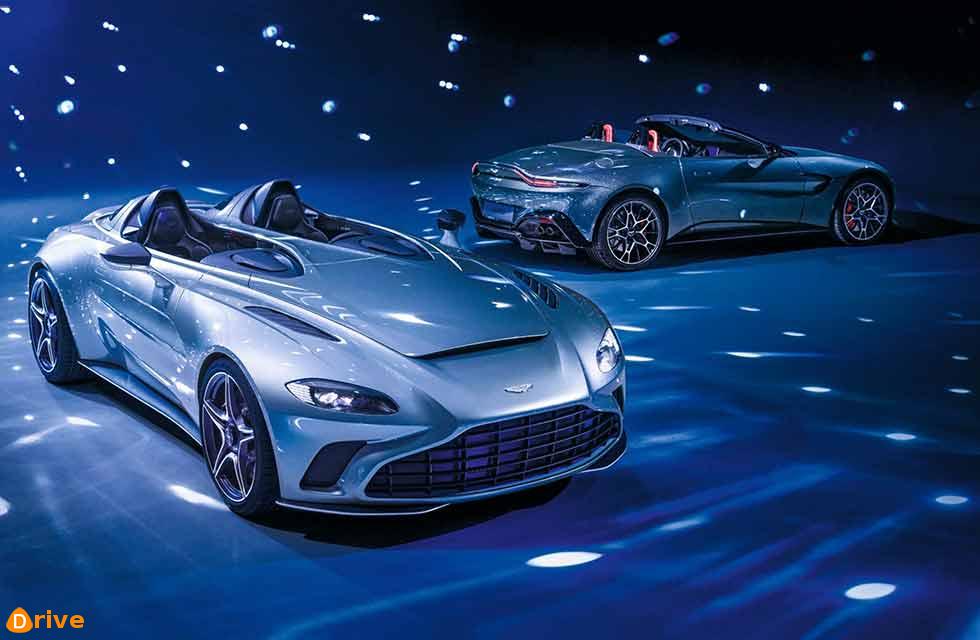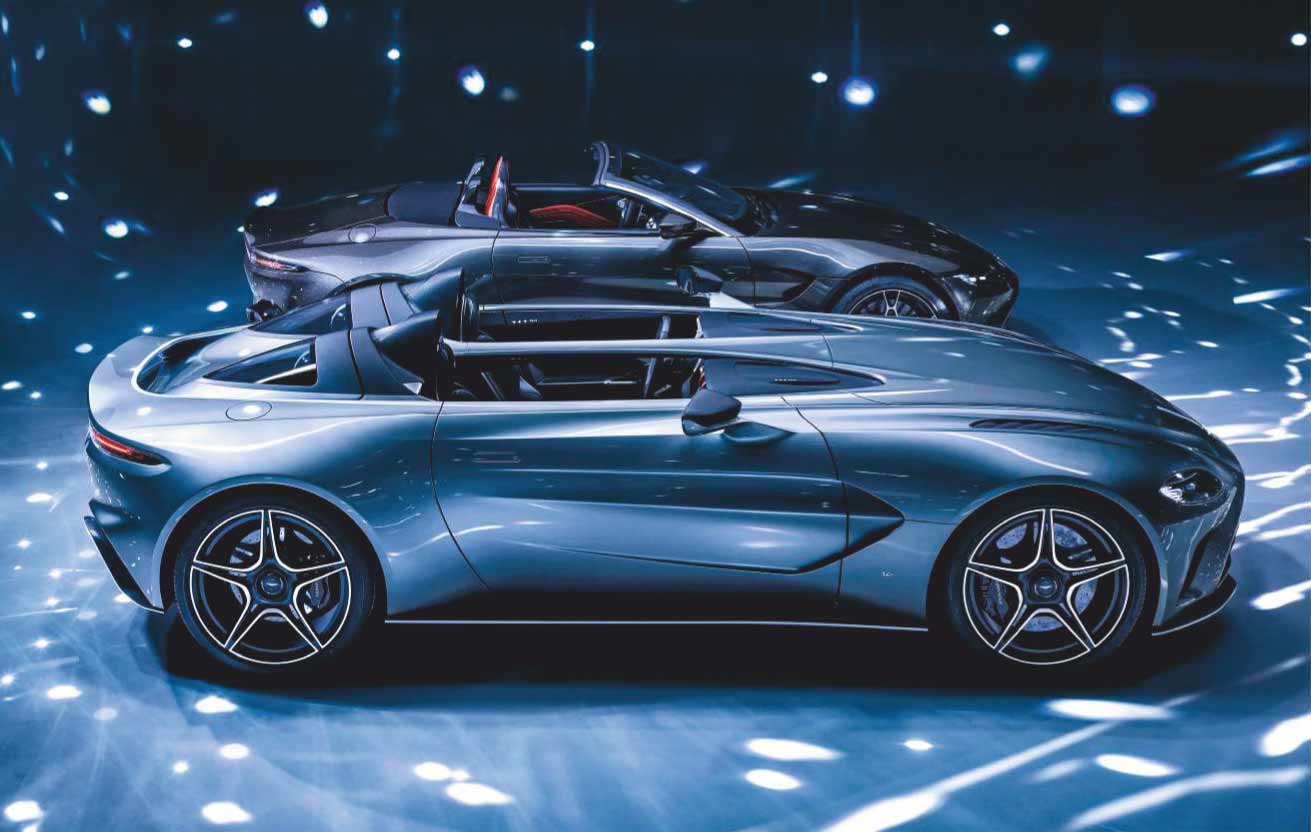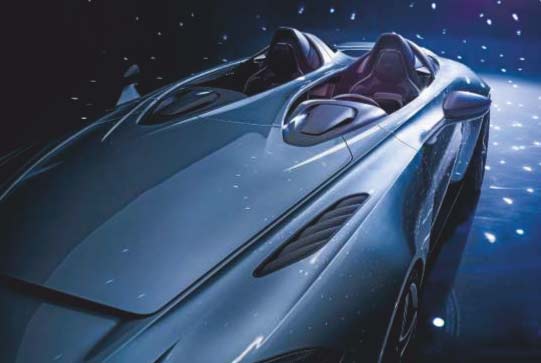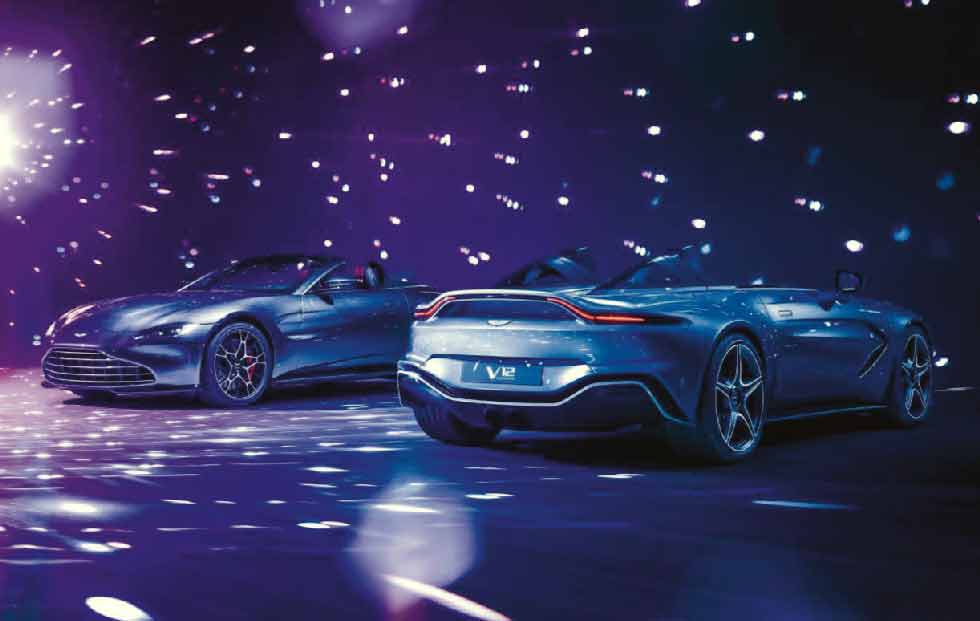Aston’s next chapter. So much is happening at Aston Martin – not all of it good. New investors have pulled things from the brink, giving these two works of art, and the CEO, breathing space. CAR investigates. Words Georg Kacher and Ben Miller. Photography Alex Howe.
CHAMPAGNE TASTE LEMONADE BUDGET
Andy Palmer
Aston Martin CEO
Former Nissan man Palmer took over as Aston CEO in 2014, and immediately commissioned the DBX
First and foremost, an Aston Martin must be irresistible. Think DB4, DB7, even Valkyrie. And now think new Vantage Volante and V12 Speedster. The timing of these two open-top sports cars is coincidental – the Speedster’s gestation was a little over a year, the Roadster in the Vantage plan from the beginning – but it is also apposite. When your back’s against the wall, your press coverage distracted by poor financials and the questions about your continued existence unending, the last thing you need is an apologetic new car.

There is nothing meek or apologetic about the V12 Speedster. Beneath, it is a happy hybrid of Vantage and DBS/DB11 chassis parts. Up front we find Aston’s spectacular twin-turbo V12 pushed to 690bhp and 555lb ft of torque. The noise, via the stainless-steel centre-exit exhaust, should be among the finest yet created by man. Via a ZF eight-speeder, the engine is able to rotate the rear wheels with sufficient conviction to bring a 0-62mph time of just 3.5sec and a terminal velocity of 186mph. Handily, the Speedster promises the grip and chassis to cope, with 21-inch wheels, ceramic brakes and a bespoke chassis tune.
But none of that matters as much as the carbonfibre body, a work of quite perfect proportions and detailing from a team, under design director Miles Nurnberger, now so reliably capable of brilliance it’s a wonder no one else has yet poached it. It is almost for their work alone that you’ll fight to ensure you’re one of the chosen 88, and to hand over £765,000. (A snip compared to Bentley’s £1.5m Bacalar, or Ferrari’s £1.6m SP2 Monza.)
More affordable but barely any less visually arresting is the £126,950 Vantage Roadster. Weight is up by just 60kg over the coupe – a small price to pay for a roof that drops in just 6.6sec, welcoming in the world, the sunshine and the V8’s unfettered racket.
‘If I was prepared to leave voluntarily, I would have done so long ago’
ANDY PALMER, CEO
So, as discussed, the cars are irresistible. Quality is not an issue. The performance of Aston’s cars leaves little to be desired. And the brand still retains that lustre forged over many decades. So why is Aston Martin under-delivering on so many key fronts? Why has it required financial assistance yet again?
‘Because we wanted too much, too fast,’ says Andy Palmer, Aston’s CEO since 2014; ‘2019 in particular was a difficult year. Residual values and demand fell because dealers had overstocked.
Then the share value started to drop at a point in time when the company needed fresh cash to develop the Valkyrie [the V12-engined Red Bull collaboration], the Valhalla [the circa £1m hybrid hypercar] and the Vanquish [the hybrid V6-engined F8 Tributo rival].’
That’s when, earlier this year, a billionaire deus ex machina by the name of Lawrence Stroll, owner of the Racing Point F1 team (formerly Force India, and to be rebranded again as Aston Martin come 2021) stepped in and bought a 20 per cent chunk of the business. Together, three key investors bring £500m – enough to keep the company going for now, if not forever. ‘Mind you,’ adds president and CEO Palmer, ‘these are difficult times, with coronavirus idling the markets. Nonetheless, our top priority is to start shipping the DBX [Aston Martin’s first SUV] in summer.
‘According to our sources, any Ferrari is substantially cheaper to build than its equivalent Aston Martin’
INDUSTRY ANALYST
‘The waiting list for this model, essential to Aston’s future, stretches way into next year, confirming that we hit the bull’s eye with it.’
Even if DBX does turn out to be a smash hit and the V12 Speedster special brings a welcome cash injection, they won’t solve the systemic problems that first beset Bond’s preferred car maker more than a decade ago. While previous CEO Ulrich Bez introduced a modular, vertically and horizontally integrated (VH) architecture to cover the entire portfolio, from entry-level Vantage to four-seat Rapide, the follow-up management under Palmer, Ian Minards (CTO), Mark Wilson (CFO, who stands down in April) and Marek Reichmann (chief creative director) appear less focused on synergies.
A case in point: the DB11 and the Vantage. Although the two-seater sports car is essentially a shortened DB11, parts commonality amounts to a mere 30 per cent. That figure may be acceptable, perhaps, on a fat-margin Zagato spin-off, but not for mainstay models. Even less overlap has allegedly been designed into the marque’s future mid-engined models, starting with this year’s flagship Valkyrie, then the Valhalla due in 2022 and the subsequent Vanquish.
For a company that sold 5809 vehicles in 2019, such deep proliferation and high complexity are hard to shoulder. When you divide the three existing front-engined model lines (the Vantage, the DB11 and the DBS), all available in coupe and roadster body styles, into individual business cases, the numbers don’t add up.
Even if the DBX SUV and V12 Speedster special bring a welcome cash injection, they won’t solve Aston’s systemic problems
Aston planned to target Ferrari by going mid-engined in three different parts of the market, but missed the point by not deploying a fully scalable lightweight architecture that could underpin them all. While the ragazzi in Maranello, under CTO Michael Leiters, can derive the Purosangue SUV from the same matrix as the mid-engined cars and the successor to the front-engined 812, Gaydon must indulge in the costly luxury of baking every new addition to the line-up to a bespoke recipe.
While the Vanquish, the car with which Aston plans to steal mid-engined sales from Ferrari, Lamborghini and McLaren, uses a composite-reinforced bonded aluminium chassis, the Valhalla – Aston’s LaFerrari – uses a carbonfibre tub, but a different carbonfibre tub to the flagship Valkyrie. In other words the all-important Vanquish is the third new mid-engined Aston Martin Gaydon must engineer from scratch.
What’s more, its 3.0-litre twin-turbo V6, which we understand is good for around 650bhp pre-electrification, has now seen the light of day in promotional material but is still at early test-bench status. It’s the same story with the electric front-drive assembly by performance EV specialists Rimac and the Graziano transmission Aston will share with Lamborghini. And while the car’s design is apparently already cast in stone, certain packaging and visibility issues are yet to be resolved.
In the case of the Valkyrie and the Valhalla, a one-off approach is less critical because, after designing the car, Aston effectively co-ordinated inputs from a string of specialist contributors like Red Bull, Rimac, Bosch, Cosworth, Michelin and Ricardo. Since every participant demands a slice of the bottom line, there won’t be a significant profit left for the initiator. Instead, Aston can only hope the subsequent halo effect boosts the brand’s image – another way of saying that the real money must be made elsewhere…
Somewhere like St Athan, Wales, home of the DBX and, eventually, the electrified Lagonda twins (now pushed back to 2025). A new product, a new factory, a new workforce – isn’t this an accident waiting to happen?
‘This is my 21st new factory,’ says a proud Palmer. ‘Although I fully expect the odd run-up glitch, we’re relying on proven assembly methods, familiar powertrains and a bulletproof electrical architecture supplied by Mercedes, as well as a set of skilled workers. In an initial audit, the first 500 DBX customer cars matched the quality level of the well-functioning Gaydon plant in all critical areas.’
Today’s Aston Martins are well put together. The engines are robust and body and trim appear to age gracefully. On the downside Aston’s interiors are strangely lacklustre across the board (the next-generation Valkyrie, Valhalla and Vanquish excepted), the generic Mercedes infotainment is embarrassingly outdated, and there is very little high technology on which to feast, either in the cabin or under the bonnet.
But what hurts Aston Martin more than anything is the absolute dominance of design over engineering. ‘Our concept cars preview the real things with a 90 per cent accuracy,’ explains Palmer, unwittingly hitting the nail on the head. Shared parts are too few and far between, common architectural elements dipped in red ink by the use of different materials. In general, ‘carry-over’ would appear a dirty word in Gaydon.
An industry analyst, who requested anonymity, puts it this way. ‘According to our sources, any Ferrari is substantially cheaper to build than its equivalent Aston Martin. The money lost on the shop floor is money Aston desperately needs for investment in technology like connectivity, driver assistance and hybridisation. In our view, the new mid-engined matrix is, in terms of cost at least, a step back from the VH layout.’
While the deposits paid for Valkyrie and Valhalla will most likely grease these two models through the system on schedule, insiders claim the Vanquish ‘junior’ mid-engined car is by no means fully funded. Instead, work is reportedly proceeding slowly, suggesting the scheduled production start date of 2022 might be a tall order.
When your back’s against the wall and your press coverage distracted by poor financials, the last thing you need is an apologetic new car
It seems the engineering team has struggled to fund the tailor-made underpinnings demanded by the eye-catching exteriors. Now this tricky task falls to new CTO Nick Lyons, who previously worked in manufacturing, was vice-president of sales and acted as chief planning officer. Lyons’ priority must be to slash costs by introducing more efficient processes, developing standardisation and embracing common componentry.
‘Aston needs a set of archetypes that co-define the fixed points of every new model,’ says our insider. ‘Trouble is, implementing this requires discipline and a willingness to make concessions on both sides of the fence [engineering and design]; a fence that must come down in the near future.’
Aston Martin’s share price has dropped by more than 75 per cent since the IPO in 2018, a reflection perhaps of the markets’ doubts about the business plan installed by Palmer, a plunge into loss last year, and net debts of around £900m which will need refinancing in stages at costly rates. While some claim the 57-year-old chairman doesn’t understand luxury like Lamborghini’s Stefano Domenicali and Ferrari’s Louis Camilleri, others criticise him for overloading his plate.
Seems top-tier collectors love V12s and detest roofs. The Speedster’s carbonfibre body is a work of quite perfect proportions and detailing
The CEO himself insists Aston is on the right track. ‘True, funds are limited, which is why we pushed back the game plan for Lagonda. But electrification has by no means been cancelled. On the contrary, we’ve made a firm commitment to hybridisation, which will filter down from the hypercar to the rest of the range.
‘And by joining F1 with our own team in 2021, we are going to benefit from the halo effect of [top-flight] motorsport. In addition, our de-stocking efforts are beginning to pay off. Every second DBX owner will be new to the brand and is a potential sports-car customer.’
The new kid on Banbury Road, 61-year-old Lawrence Stroll, delivered his inaugural video speech as executive chairman in an ill-fitting grey pinstripe suit, called Aston ‘a fantastic company’ and underlined his intention ‘to build the pre-eminent global luxury brand’. Industry watchers and the car maker’s inner circle are eagerly awaiting the next board meeting – slated for 27 April – at which the owners are expected to ‘reset the business plan’ and detail their strategy for a profitable future.
Will that reset leave Palmer in charge? ‘If I was prepared to leave voluntarily, I would have done so long ago,’ says Palmer, side-stepping the question of whether or not the investors will support his system. Says Palmer of Stroll: ‘He is good for Aston, he is phenomenally successful in luxury, and he is not going to be passive.’ This cliffhanger’s next chapter starts here.
A couple of metres (and half a million quid) between them What finer for the thrash south to Goodwood? Still want Aston to go mid-engined? Looks capable of flight. V12 almost is. Body separates driver and passenger – but they can still hold hands.
WORLD, SAY HI TO THE TM01
ASTON’S NEXT-GEN HYBRID V6 IS GO
When Aston Martin unveiled the Vanquish and Valhalla, as surprising as the news that they’d be mid-engined was confirmation that Aston would create the powertrain – an integrated, future-proofed high-performance V6 hybrid – in-house.
Now, despite Aston’s financial woes, we have some details. Here’s what makes it tick.
EVERYONE LOVES A HYBRID V6
Like McLaren, Ferrari and the F1 pitlane, Aston’s calculations (by engine guru Joerg Ross and, initially, by ex-Ferrari man Max Szwaj) saw it arrive at a familiar solution: a turbo V6 in combination with a battery and e-motor/ generator. The advantages are myriad. V6s are light and easy to package, while turbocharging ups specific output and helps with efficiency.
HOT-IN-VEE TURBOCHARGING
Old school turbocharging tended to mount the turbines outboard of the engine, for cooling and to ease packaging. But the TM01 (after Aston engineering legend Tadek Marek) – in line with modern practice – sticks the turbines within the vee of the cylinder heads. Weight is reduced, while the shorter distances between manifold and turbo improve response.
100 PER CENT ASTON MARTIN
Terrifyingly for its accountants, the powertrain is 100 per cent Aston. ‘This new V6, it’s all us,’ CEO Palmer told CAR at the Vanquish’s unveiling. ‘We recruited Joerg Ross [ex-Ferrari, ex-Maserati] and this new turbo V6 is his baby. The two technologies [turbocharging and hybrid power] complement each other; turbos brings lag, but the electric motor gives torque and instant response.’
BEST OF BOTH WORLDS
As you’d expect of a sports car engine, the TM01 is drysumped (for a low centre of gravity) and blessed with a lubrication system capable of scavenging even while you’re driving like a lunatic. Made of aluminium and displacing 3.0 litres, Aston claims that, in combination with its e-drive unit, the TM01 powertrain will be ‘the most powerful in the Aston Martin range’ when it goes on sale in 2022.
ASTON’S FIRST CENTURY
1913 ASTON’S FIRST AGE
Founded in the year before the War, Aston barely lasts a decade in its original guise. ‘Aston’ comes from the Aston Clinton hillclimb, ‘Martin’ from co-founder Lionel Martin.
1947 IN COMES BROWN
Like a ’40s Lawrence Stroll, wealthy businessman David Brown brings money and new ideas. He initially answers an ad in The Times offering a sports-car company for £20,000…
1959 THE FIRST FORMULA 1 CAR
The logical move, after cleaning up in sports-car racing through the ’50s, is Formula 1. The DBR4, with its 2.5-litre straight-six, looks right and goes well but the results don’t come.
1974 BUST AGAIN
After years of financial strife, Brown pays off the company’s debts and sells to a consortium. Receivership follows in ’1974, Aston hurt by global recession and California’s clean-air programme damaging US sales.
1976 MASTERPIECE! THE SERIES 2 LAGONDA
Still one of the most remarkable four-seaters ever created, the Lagonda is hurried into existence to broaden sales beyond the two-seat sports car maker. Innovative like the first iPod but with a V8.
1987 THE NAME’S GAUNTLETT
Victor Gauntlett’s involvement begins in 1980, and Aston spends the ’80s getting back on track, not least with a Royal Warrant in ’1982 and a return to James Bond with the V8 Vantage in The Living Daylights.
1995 700 CARS!
Ford ownership brings modernity and an increased rate of production. By 1995, with the DB7 doing the business, sales hit 700 units – just over a decade earlier, in ’1982, Aston had sold just 30 cars…
2014 IN COMES PALMER
After Ulrich Bez and David Richards comes ex-Nissan man Andy Palmer. By 2017 Aston has returned to profit, helped by an engine and electronics tie-up with Daimler.
2018 A MIXED YEAR…
In early 2018 the world claps eyes on the Valkyrie, an astonishing statement of intent combining a Cosworth V12 with Red Bull aerodynamics and otherworldly performance. In October Aston floats on the Stock Exchange – it doesn’t go brilliantly…














